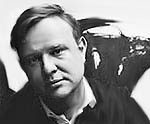 |
|||||
|
Robert Motherwell (1915-1991) |
||||
|
Robert Motherwell was one of the leading artists of the Abstract Expressionist movement and also the leading spokesman for that generation. His paintings, collages, drawings, and prints are in the collections of major museums throughout the world and he remains the subject of intense art-historical study. His work is characterized by a broad range of imagery, within which there are certain recurrent themes and motifs, such as the monumental Elegies to the Spanish Republic, the intensely brooding Iberia paintings, and the lyrical Opens. Robert Motherwell was born in Aberdeen, Washington, on January 24, 1915, the first child of Robert Burns Motherwell II and Margaret Hogan Motherwell. He was reared largely on the Pacific Coast and spent most of his school years in California, where he graduated from Stanford University in 1937. Motherwell also did graduate work in philosophy at Harvard University and in 1940 he studied briefly at Columbia University, where he was encouraged by Meyer Schapiro to devote himself to painting rather than scholarship. After a 1941 voyage to Mexico with the Surrealist painter Matta, Motherwell decided to make painting his primary vocation. It was at this time that he began to do "automatic" drawings and painted his first mature pictures. The next year Motherwell began to exhibit his work in New York and in 1944 he had his first one-man show at Peggy Guggenheim's “Art of this Century” Gallery. Beginning in the mid-1940s, Motherwell became the leading spokesman for avant-garde art in America. He lectured widely on abstract painting and he founded and edited the Documents of Modern Art Series. In 1948, he began to work with his celebrated Elegy to the Spanish Republic theme, which he continued to develop throughout his life. From 1950 to 1959, Motherwell taught painting at Hunter College, in New York. At this time, he was a prolific writer and lecturer, and in addition to directing the influential Documents of Modern Art Series, he edited The Dada Painters and Poets: An Anthology, which was published in 1951. |
 In
1958, Motherwell was included in the "The New American Painting"
exhibition at the Museum of Modern Art. That year he traveled in France
and Spain, where he started his Iberia series. During the 1960s, Motherwell
exhibited widely in both America and Europe and in 1965 he was given
a major retrospective exhibition at the Museum of Modern Art; this
show subsequently traveled to Amsterdam, London, Brussels, Essen,
and Turin. In 1967, Motherwell began to work on his Open series. In
1958, Motherwell was included in the "The New American Painting"
exhibition at the Museum of Modern Art. That year he traveled in France
and Spain, where he started his Iberia series. During the 1960s, Motherwell
exhibited widely in both America and Europe and in 1965 he was given
a major retrospective exhibition at the Museum of Modern Art; this
show subsequently traveled to Amsterdam, London, Brussels, Essen,
and Turin. In 1967, Motherwell began to work on his Open series.
In 1970, Motherwell moved to Greenwich, Connecticut. During the 1970s, he had important retrospective exhibitions in a number of European cities, including Dusseldorf, Stockholm, Vienna, Paris, Edinburgh, and London. In 1977, Motherwell was given a major mural commission for the new wing of the National Gallery of Art, Washington, D.C. In 1983, a major retrospective exhibition of Motherwell’s work was mounted at the Albright-Knox Art Gallery in Buffalo, New York; this exhibition was subsequently shown in Los Angeles, San Francisco, Washington, D.C., Seattle, and New York City. Another retrospective was shown in Mexico City, Monterey, and Fort Worth, Texas, in 1991. Robert Motherwell died in Provincetown, Massachusetts on July 16, 1991. Over a long and distinguished career, Motherwell was the recipient of numerous awards and honors, and his works are on display in museums throughout the world. Since his death there have been numerous exhibitions of his work, including a major retrospective shown in Barcelona and Madrid in 1997.
|
|||
|
||||
| Home | The
Dedalus Foundation | About Motherwell
| Questionnaire | Contact |
||||
